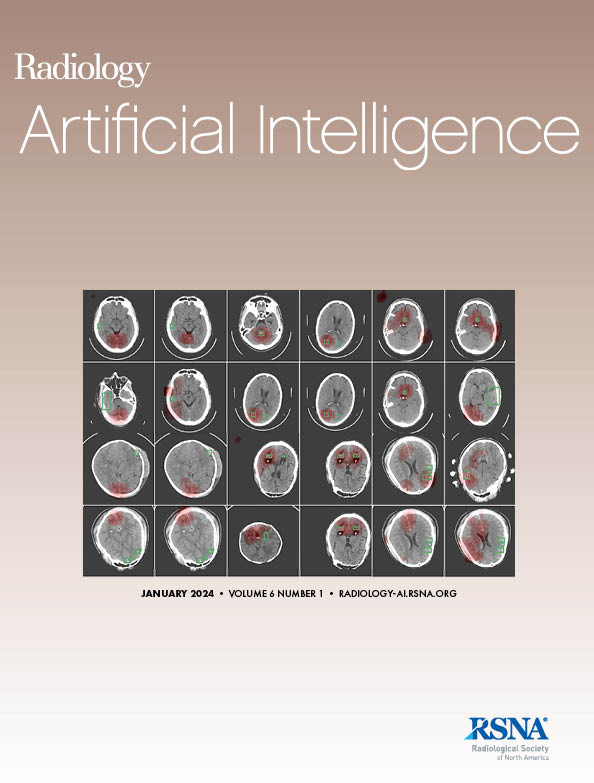Xiaopeng Kang, Jiaji Lin, Kun Zhao, Shaozhen Yan, Pindong Chen, Dawei Wang, Hongxiang Yao, Bo Zhou, Chunshui Yu, Pan Wang, Zhengluan Liao, Yan Chen, Xi Zhang, Ying Han, Jie Lu, Yong Liu
求助PDF
{"title":"基于结构mri的阿尔茨海默病计算机辅助诊断模型:对错误分类和诊断局限性的见解。","authors":"Xiaopeng Kang, Jiaji Lin, Kun Zhao, Shaozhen Yan, Pindong Chen, Dawei Wang, Hongxiang Yao, Bo Zhou, Chunshui Yu, Pan Wang, Zhengluan Liao, Yan Chen, Xi Zhang, Ying Han, Jie Lu, Yong Liu","doi":"10.1148/ryai.240508","DOIUrl":null,"url":null,"abstract":"<p><p><i>\"Just Accepted\" papers have undergone full peer review and have been accepted for publication in <i>Radiology: Artificial Intelligence</i>. This article will undergo copyediting, layout, and proof review before it is published in its final version. Please note that during production of the final copyedited article, errors may be discovered which could affect the content.</i> Purpose To examine common patterns among different computer-aided diagnosis (CAD) models for Alzheimer's disease (AD) using structural MRI data and to characterize the clinical and imaging features associated with their misclassifications. Materials and Methods This retrospective study utilized 3258 baseline structural MRIs from five multisite datasets and two multidisease datasets collected between September 2005 and December 2019. The 3D Nested Hierarchical Transformer (3DNesT) model and other CAD techniques were utilized for AD classification using 10-fold cross-validation and cross-dataset validation. Subgroup analysis of CAD-misclassified individuals compared clinical/neuroimaging biomarkers using independent <i>t</i> tests with Bonferroni correction. Results This study included 1391 patients with AD (mean age, 72.1 ± 9.2 years, 757 female), 205 with other neurodegenerative diseases (mean age, 64.9 ± 9.9 years, 117 male), and 1662 healthy controls (mean age, 70.6 ± 7.6 years, 935 female). The 3DNesT model achieved 90.1 ± 2.3% crossvalidation accuracy and 82.2%, 90.1%, and 91.6% in three external datasets. Further analysis suggested that false negative (FN) subgroup (<i>n</i> = 223) exhibited minimal atrophy and better cognitive performance than true positive (TP) subgroup (MMSE, FN, 21.4 ± 4.4; TP, 19.7 ± 5.7; <i>P<sub>FWE</sub></i> < 0.001), despite displaying similar levels of amyloid beta (FN, 705.9 ± 353.9; TP, 665.7 ± 305.8; <i>P<sub>FWE</sub></i> = 0.47), Tau (FN, 352.4 ± 166.8; TP, 371.0 ± 141.8; <i>P<sub>FWE</sub></i> = 0.47) burden. Conclusion FN subgroup exhibited atypical structural MRI patterns and clinical measures, fundamentally limiting the diagnostic performance of CAD models based solely on structural MRI. ©RSNA, 2025.</p>","PeriodicalId":29787,"journal":{"name":"Radiology-Artificial Intelligence","volume":" ","pages":"e240508"},"PeriodicalIF":13.2000,"publicationDate":"2025-07-30","publicationTypes":"Journal Article","fieldsOfStudy":null,"isOpenAccess":false,"openAccessPdf":"","citationCount":"0","resultStr":"{\"title\":\"Structural MRI-based Computer-aided Diagnosis Models for Alzheimer Disease: Insights into Misclassifications and Diagnostic Limitations.\",\"authors\":\"Xiaopeng Kang, Jiaji Lin, Kun Zhao, Shaozhen Yan, Pindong Chen, Dawei Wang, Hongxiang Yao, Bo Zhou, Chunshui Yu, Pan Wang, Zhengluan Liao, Yan Chen, Xi Zhang, Ying Han, Jie Lu, Yong Liu\",\"doi\":\"10.1148/ryai.240508\",\"DOIUrl\":null,\"url\":null,\"abstract\":\"<p><p><i>\\\"Just Accepted\\\" papers have undergone full peer review and have been accepted for publication in <i>Radiology: Artificial Intelligence</i>. This article will undergo copyediting, layout, and proof review before it is published in its final version. Please note that during production of the final copyedited article, errors may be discovered which could affect the content.</i> Purpose To examine common patterns among different computer-aided diagnosis (CAD) models for Alzheimer's disease (AD) using structural MRI data and to characterize the clinical and imaging features associated with their misclassifications. Materials and Methods This retrospective study utilized 3258 baseline structural MRIs from five multisite datasets and two multidisease datasets collected between September 2005 and December 2019. The 3D Nested Hierarchical Transformer (3DNesT) model and other CAD techniques were utilized for AD classification using 10-fold cross-validation and cross-dataset validation. Subgroup analysis of CAD-misclassified individuals compared clinical/neuroimaging biomarkers using independent <i>t</i> tests with Bonferroni correction. Results This study included 1391 patients with AD (mean age, 72.1 ± 9.2 years, 757 female), 205 with other neurodegenerative diseases (mean age, 64.9 ± 9.9 years, 117 male), and 1662 healthy controls (mean age, 70.6 ± 7.6 years, 935 female). The 3DNesT model achieved 90.1 ± 2.3% crossvalidation accuracy and 82.2%, 90.1%, and 91.6% in three external datasets. Further analysis suggested that false negative (FN) subgroup (<i>n</i> = 223) exhibited minimal atrophy and better cognitive performance than true positive (TP) subgroup (MMSE, FN, 21.4 ± 4.4; TP, 19.7 ± 5.7; <i>P<sub>FWE</sub></i> < 0.001), despite displaying similar levels of amyloid beta (FN, 705.9 ± 353.9; TP, 665.7 ± 305.8; <i>P<sub>FWE</sub></i> = 0.47), Tau (FN, 352.4 ± 166.8; TP, 371.0 ± 141.8; <i>P<sub>FWE</sub></i> = 0.47) burden. Conclusion FN subgroup exhibited atypical structural MRI patterns and clinical measures, fundamentally limiting the diagnostic performance of CAD models based solely on structural MRI. ©RSNA, 2025.</p>\",\"PeriodicalId\":29787,\"journal\":{\"name\":\"Radiology-Artificial Intelligence\",\"volume\":\" \",\"pages\":\"e240508\"},\"PeriodicalIF\":13.2000,\"publicationDate\":\"2025-07-30\",\"publicationTypes\":\"Journal Article\",\"fieldsOfStudy\":null,\"isOpenAccess\":false,\"openAccessPdf\":\"\",\"citationCount\":\"0\",\"resultStr\":null,\"platform\":\"Semanticscholar\",\"paperid\":null,\"PeriodicalName\":\"Radiology-Artificial Intelligence\",\"FirstCategoryId\":\"1085\",\"ListUrlMain\":\"https://doi.org/10.1148/ryai.240508\",\"RegionNum\":0,\"RegionCategory\":null,\"ArticlePicture\":[],\"TitleCN\":null,\"AbstractTextCN\":null,\"PMCID\":null,\"EPubDate\":\"\",\"PubModel\":\"\",\"JCR\":\"Q1\",\"JCRName\":\"COMPUTER SCIENCE, ARTIFICIAL INTELLIGENCE\",\"Score\":null,\"Total\":0}","platform":"Semanticscholar","paperid":null,"PeriodicalName":"Radiology-Artificial Intelligence","FirstCategoryId":"1085","ListUrlMain":"https://doi.org/10.1148/ryai.240508","RegionNum":0,"RegionCategory":null,"ArticlePicture":[],"TitleCN":null,"AbstractTextCN":null,"PMCID":null,"EPubDate":"","PubModel":"","JCR":"Q1","JCRName":"COMPUTER SCIENCE, ARTIFICIAL INTELLIGENCE","Score":null,"Total":0}
引用次数: 0
引用
批量引用

 求助内容:
求助内容: 应助结果提醒方式:
应助结果提醒方式:


